This small French car had everything to succeed among young people who could enjoy it with little investment (it cost less than two million pesetas), and offered an excellent basis for learning to drive spiritedly, or even start in the rallies.
The history of the Citroën Saxo dates back to 1991. At that time, Peugeot, the owner of Citroën, was looking to cover the market with a model smaller than the 205, more economical, but also more robust and safer than the Citroën AX that the double chevron firm had on sale at the time.
It launched the Peugeot 106 that year, as an A-segment car, with great commercial success. No less than five years after that 106, which was already the protagonist of our USPI last year in its Rally variant, PSA decided to try to cover more of the segment cloning the 106 with Citroën logo.
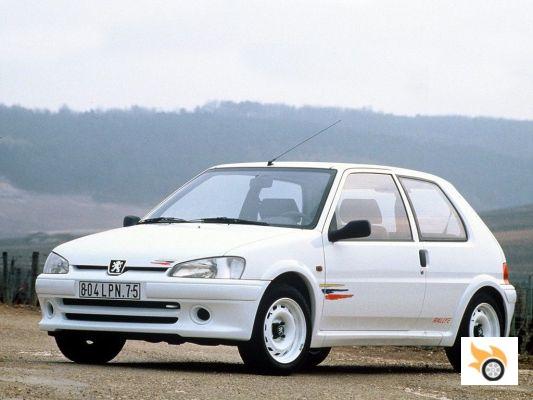
Born five years after the 106, it shared a lot of parts with the 106.
Thus the Saxo was born. The Saxo's aim was to target the B-segment, which was difficult given that it was smaller than its rivals. Although the brand's managers did not recognize it at the time, the Saxo was born to relieve the veteran AX, which was already showing its age.
The Saxo shared almost everything with the 106. Platform, mechanical elements... And how could it be otherwise, also inherited the spirit of creating sporty variants. Several sporty Saxos were born, the VTR with 1.4 engine, the VTS with 1.6 engine and eight valves, and finally, the protagonist of our today's section, the 1.6 16 valves.
Between its front wheels was the TU5 J4 block, with 16 valves driven by a double overhead camshaft, 1,600 cubic centimeters and 120 hp and 145 Nm of torque delivered through a five-ratio gearbox. The front suspension was by simple McPherson struts, while the rear suspension was made up of a bridge with two transverse torsion bars acting on some pulled hoses on which the wheels rested.
The VTS and VTR models also had disc brakes on both axles (the rest of Saxos were satisfied with drums at the rear), and the VTS added ventilated front discs.
A simple interior, and little equipment
The cabin offered a low driving position and a large boot.
To open the Saxo's door is to travel back to the early 1990s in many ways. And the VTS was launched in 1997... but being the almost twin brother of the 106 had these things.
Although the Saxo was offered with equipment such as side airbags or front passenger airbags, or ABS, many of these elements were optional, and many units did not end up integrating them.
There is, however, room for central locking and electric windows. It's all very spartan, and very tall people (1.85 and up) may not even fit in its driver's seat. If you're my size (1.73) you'll find a driving position with a steering wheel that, while not adjustable, is well placed (though perhaps a little low for some tastes). Behind it is a much more complete gauge cluster than the ones we see nowadays in terms of real information: it not only includes coolant temperature, but also oil temperature. That's something!
It sits way down low, and that helps, as we'll tell you later, in the driving experience. But before starting the engine, it's time to take a look at the space available. The rear seats are tight, typical of a current A-segment, or worse (my Abarth 500 has more space), while the 280-litre boot seems large for what the car measures on the outside (3.7 metres). It is a city car, and as such you can perfectly live with it to go to class, to work or to do the shopping, only those who have to constantly get in and out of the rear seats, if that is the case, can complain.
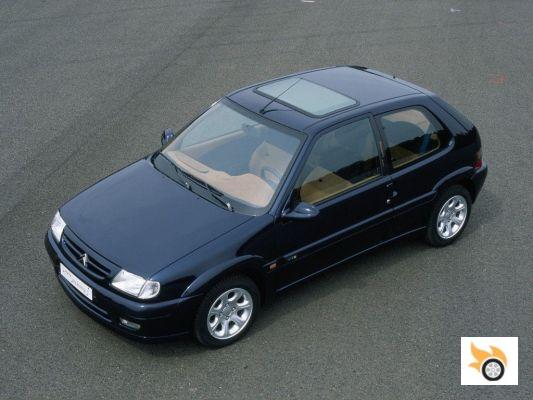
I won't say much about the aesthetics of the car. It was a 106 with a Citroën face, which, at least in my opinion, looked better before the restyling that gave it "women's headlights". The original design, "with some ZX" worked better. The use of oversized wheel arches, a "racing" bumper, the exhaust tail, the spoiler on the rear hood and the low suspension made the car look "macho" and "racing", come on, fat, despite being little more than a utility car.
Start and have fun
There are three key features of the Saxo VTS that make it particularly interesting: It weighs very, very little. It's low and short (it has a low centre of gravity and a low polar moment of inertia); and finally, it has a playful set-up.
When you start it up and get going with it you don't feel a sudden rush of torque or power. In fact the 16-valve engine asks you to spin it fast to get the best out of it, because down low it has little to offer (not having variable valve timing).
But when you start attacking corners you forget a bit about that possible lack of initial "chicha" in favor of everything that comes through your senses. You're sitting low, and you feel the road perfectly. The car tells you what's going on under its wheels. The steering, in addition to being precise and just the right weight, is very informative.
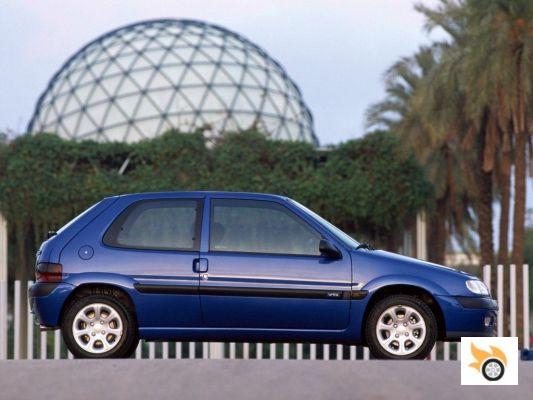
In slow corners, you can play with the rear, hollowing out the throttle in support suddenly to close the turn and yaw the car into the apex. Getting on the gas at the exit of the corner is no problem, because with less than 150 Nm of torque, you won't lose any wheels.
The braking system is effective, considering that the car weighs just over 950 kilos, and playing with the engine near the cut-off is fun.
The pedals allow you to "play rally", heel-toe included, and everything flows easily. As it is not a devilishly fast car, but very lively, we can consider it a perfect school car.
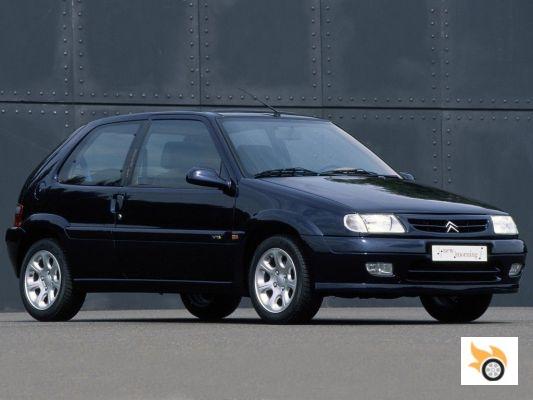
It changes direction without a fuss, it has a responsive rear end, the steering tells you how much grip is available, and it's also able to swallow bumps in support.
And, thanks to its low height, it doesn't need a hard and dry suspension to control its movements. The damping is very successful, and combines just the right amount of stiffness to avoid wobbling, with an absorption capacity that will leave you astonished, because no matter how much the asphalt curls, the car doesn't bounce or lose traction.
As the road unwinds and gets faster, the Saxo loses its agility advantage. It's a stable car in any case, and it's not scary on the motorway, despite its small size, but it's not a car to be enjoyed from fourth gear upwards, really.
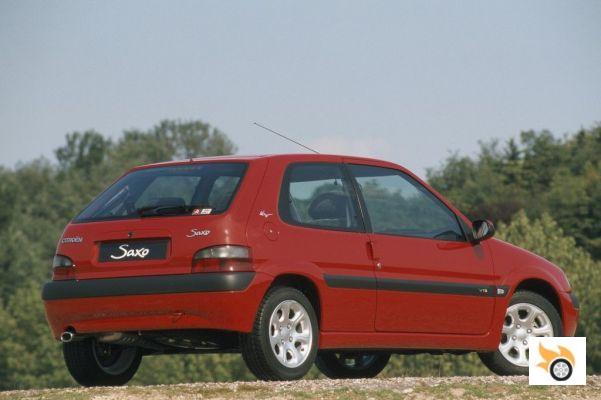
If you have to use it daily, it is an acceptable "all-purpose car". It's not a lighter, because it uses quite a lot of fuel for what it measures and weighs, especially if you compare it with more modern machinery, and as I said above, you might miss some punch at low revs. But otherwise it will serve you "for everything and every day".
What to check and what gives problems
The main problem with these little cars is finding a decent one. With such a low starting price, many of them have changed hands over the last decade, falling into the hands of owners who are not very careful with their mechanical condition.
We recommend you to avoid modified and prepared cars. Finding a unit that is "as stock as possible" should be your first priority before you start looking at any problems it may have.
- Suspensions: The first thing to look at on these cars is an endemic problem with the rear suspension design. The hoses swing and hinge on bearings that tend to take up slack, and cause the rear wheels to have play. This is noticeable by the inaccuracy of the car's track, which seems to "dance" constantly, and also by various noises and creaks over bumps. If you put the car on a lift you will see the rear wheels move. It's best to look for a car that has this right, although replacing the bearings in question is not necessarily expensive.
- Engine: The truth is that the TU5 is hard as a rock. The biggest of its problems is that it hasn't been maintained properly in terms of lubrication and coolant. It is necessary to verify that there is no oil in the coolant ("mayonnaise" in the expansion can), that the coolant has a suitable color (that is not more stale than the coffee of an airplane), and that the timing belt is changed when it's due.
There have been many cases of overheated engines, but not because the TU5 J5 is an engine with this endemic fault, but because of bad maintenance and bad care.
The belt is vital, so it's better to be sure it's up to date, or it will be necessary to change it without paying attention to the kilometres to avoid greater evils. Some cars have problems with injectors, but this is not very typical. If it happens, the car jerks at mid-range. It is better to get away from that seller if that happens. The same can be said if the engine is hard to start, because the problem will have to do with the power system. That's a bad thing.
- Bodywork and undercarriage: It doesn't tend to accumulate rust, although in the rear wheel arches it's not entirely unreasonable. Check the bearings and silentblocks is something that, as in any car, must be done.
The hydraulic power steering can have small leaks in the pump shaft, and also in its conductions, so you have to check it just in case.
- Electrical system: Believe it or not, it doesn't usually give problems. And yes, it's a Citroën.
- Other: The seats and their standard adjustment system aren't the most robust thing on this planet, so you need to check that you can put the seat where you want it and it doesn't change position on its own while you're using it.
What to modify
There are few cars I can think of for which more parts and items have been made to fit, although they are almost all on the decline now.
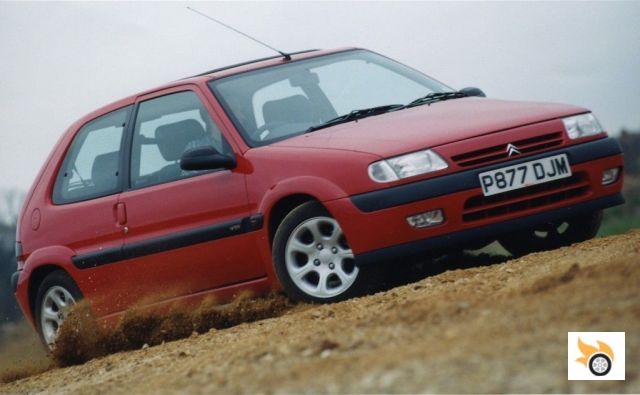
My first piece of advice is that if you find a unit in good condition, unmodified, don't touch anything or almost anything, as you risk destroying its resale value. It's a car that runs very well as standard, and anything you touch can compromise its capabilities.
Knowing this, there are in the market a collection of elements such as intake filters and exhaust lines with more open collectors that allow to gain some horsepower to the engine at the cost of losing more bass. In the suspension you can find more restrictive shock absorbers, but the standard absorption capacity is lost. Including a few millimeters spacers improves cornering, but with the passage of kilometers you risk destroying wheel hub bearings and also the rear axle.conclusions
Few cars fit the "good-pretty-cheap" bill better than this Saxo VTS. Yes, it has that aura of a neighborhood punk car tuned with "bumping sound" at full blast on a Saturday at three in the morning. But the reality is that under that stigma hides a great sport utility of which every day there are fewer units in "decent and dignified" state.
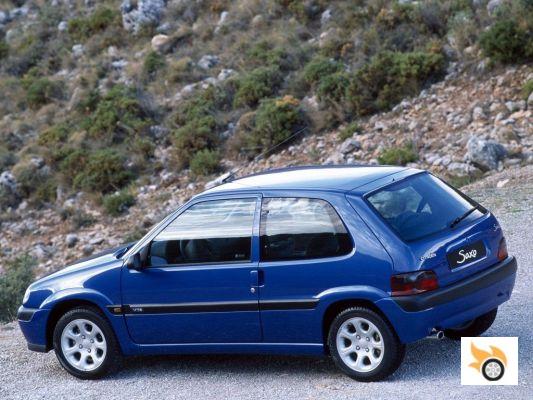
It's the epitome of a car you can have a lot of fun with for very little money.
In fact, I'll tell you that you can bet on this car as a future classic 205 GTI style, which, with the sifting of those who have dismembered them, will end up being scarce, sought after and widely used in classic rallies. But that's a long, long time away.
Before that time comes, this car is a great alternative for all those who want to exercise their spirit driving, get a good pair of hands and learn what "real" driving is all about.
If you find a worthy unit, few cars of its price will get you more smiles per kilometer.

























